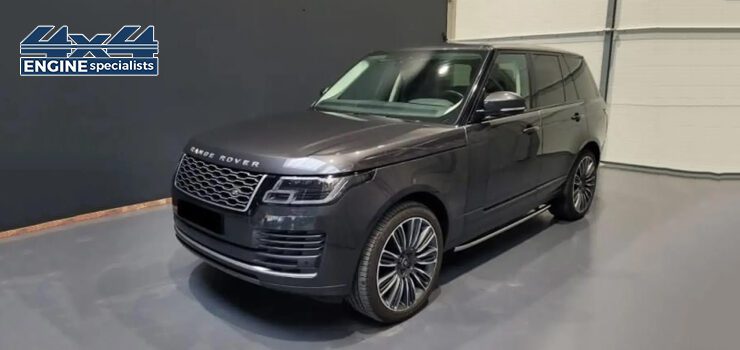The Range Rover Engine 3.0 is today’s benchmark in modern automobile engineering, with the perfect blend of performance, efficiency, and eco-friendliness. In light of global environmental concerns over carbon emissions, their implications, and what can be done to reduce them, car manufacturers such as Land Rover have developed technologies to decrease pollutants while still achieving the powerful capabilities Range Rover engines are so renowned for. Emission reduction technologies in the Range Rover Engine 3.0 make it compliant with stricter regulations and pave the way for a more sustainable future. We explore cutting-edge innovations in this engine, highlighting the benefits of these systems and their impact on overall vehicle performance. Moreover, we delve into the importance of reconditioned engines and their role in sustainability.
Advanced Exhaust Gas Recirculation (EGR) System
The EGR system in the Range Rover Engine 3.0 is one of the major components that ensure NOx emissions are decreased. This is done by sending back some of the exhaust gases produced by the engine to the combustion chamber. The combustion temperature is reduced, hence lowering the NOx emission.
A cooler combustion process emits fewer NOx, one of the most virulent pollutants emitted by a fuel-burning internal-combustion engine. It features an electronically controlled 3.0-liter engine EGR system that monitors the amount of exhaust gas returned into the engine based upon the driving conditions.
This technology not only complies with the emissions regulations but also contributes to better fuel efficiency. Reconditioned engines with updated EGR systems provide an excellent opportunity for owners to retrofit their vehicles with the latest emission-reducing technologies without having to invest in a new engine. This aligns with eco-friendly practices, ensuring older Range Rovers contribute to a cleaner environment.
SCR Technology
One of the most effective SCR technologies to reduce NOx emissions in diesel engines is the Range Rover Engine 3.0. The technology injects a urea-based solution, known commonly as Diesel Exhaust Fluid (DEF), into the exhaust stream.
This process allows the harmful NOx to be converted into harmless nitrogen and water vapor. It minimizes emissions as much as possible. The advanced sensors and control units that the Range Rover 3.0 engine’s SCR system provides ensure that DEF injection is precisely made, resulting in ideal performance in a wide range of conditions.
This technology also extends the service life of diesel particulate filters by reducing the amount of soot that accumulates, thereby improving the durability of the engine. Purchasers of reconditioned engines will have the advantage of updated SCR systems, and their vehicles will be able to meet the current emission standards while retaining peak performance.
Diesel Particulate Filter (DPF) Efficiency
This engine design features the Range Rover Engine 3.0 with a DPF, which traps exhaust particulates and stores them as soot. It filters and captures particulate matter before reducing it into its elements by burning off the stored soot.
The 3.0 engine comes with an intelligent DPF system that monitors and identifies the optimal time for regeneration in order to avoid such things as clogging and degradation of performance. Another advance in the DPF technology was in the filter material and design, which improved its efficiency and durability.
Reconditioned engines, which include these advanced DPF systems, are one of the cost-effective solutions that owners can use to reduce their environmental footprint. This is because retrofitting an older Range Rover engine with an efficient DPF can make it meet modern emission standards and thus be in compliance and eco-friendly.
Turbocharging and Emission Control
Turbocharging is another critical technology in the Range Rover Engine 3.0, improving both power output and emission control. By compressing the air entering the engine, the turbocharger increases combustion efficiency, which results in fewer unburned fuel particles and lower emissions.
Modern turbochargers in the Range Rover 3.0 engine have variable geometry, which provides accurate control of airflow according to the load on the engine. This will ensure that the emissions are reduced even at high-performance driving.
The reconditioned engines, fitted with modern turbochargers, offer improved performance and less damage to the environment. Turbocharged engine systems not only offer a great deal in terms of efficiency but also align with the objective of sustainable motoring.
In-Line Four with Low Emissions Combustion
It is also improved its combustion, as Range Rover makes 3.0-engine even better without losing speed through an advanced fuel system in injector and optimizing the chambers so that combustion is clean along with perfect management of fuel mix within an air mixture.
Multi-stage fuel injection in the engine atomizes diesel fuel for a more efficient and cleaner burn, together with computer-controlled ignition timing. This results in minimal emissions of NOx and particulate matter.
Vehicles reconditioned with new low-emission combustion are to balance performance with environmental considerations. A well-retrofitted modern combustion technology on older engines ensures that their use-life can be extended with tight standards in emission.
Light-Weighted Engine Components and Efficiency
Another innovative approach used in the Range Rover Engine 3.0 is to make the engine lighter in overall weight to reduce emissions. A lighter engine requires less energy to operate, which translates to better fuel efficiency and decreased CO2 emissions.
The use of high-strength aluminum alloys and composite materials has contributed to a significant reduction in engine weight without compromising durability. Additionally, lightweight engine components enable smoother operation, reducing wear and tear on the engine.
Reconditioned engines often replace outdated materials with these lightweight alternatives, providing a cost-effective and environmentally friendly solution. This ensures that even older Range Rover models can benefit from reduced emissions and improved fuel efficiency.
Hybrid Integration and Emissions Control
The Range Rover Engine 3.0 is part of Land Rover’s transition toward electrification, with mild hybrid systems integrated into the engine design. These systems reduce emissions by using a battery-powered motor to assist the internal combustion engine during acceleration and deceleration.
This hybrid integration decreases the load on the engine, thus reducing fuel consumption and emissions. In addition, the energy captured from braking is stored in the battery, which further improves efficiency.
Reconditioned engines with hybrid components offer an environmentally friendly option for drivers seeking to adopt green technology without the purchase of a new vehicle. The engines improve performance while dramatically reducing emissions.
Software Optimization for Emissions Compliance
Software is an important aspect of ensuring that the Range Rover Engine 3.0 complies with emission standards. Advanced Engine Control Units (ECUs) use real-time data to monitor and adjust various parameters, including fuel injection timing, air intake, and exhaust flow.
These adjustments are essential for achieving peak performance and minimizing emissions based on driving conditions. Over-the-air software updates in the Range Rover 3.0 engine also allow continuous improvement in terms of compliance with emissions.
Reconditioned engines usually have updated software. Older engines can thus take advantage of the latest advancements in the management of emissions. It is not only the longevity of the engine but also its compliance with current and future regulations on emissions.


